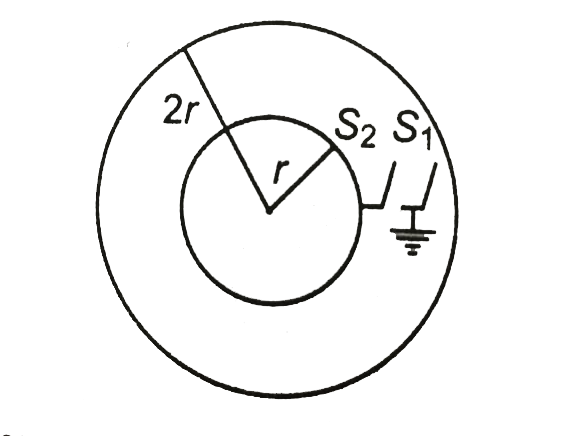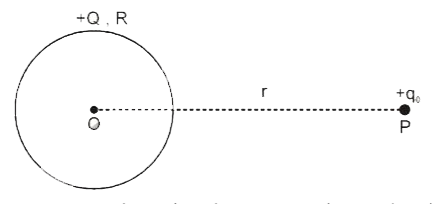See the figure here. We have two hollow thin spherical shells A and B of radii R, and R, respectively. Initially as shown in Fig. (i) shell B has a charge + Q which is uniformly distributed over its outer surface but shell B has no charge. At a particular instant the two spherical shells are connected by a thin copper wire as shown in Fig. (ii). After a couple of minutes two spherical shells A and B are disconnected again as shown in Fig. (iii).

Now answer the following questions :
What is the ratio of final electric potentials of shell A and shell B ?
When two spherical shells are connected, electric charge flows from shell A to shell B till the two acquires a common potential V. So, we have
VAVB=VV=11
Topper's Solved these Questions
- ELECTROSTATIC POTENTIAL AND CAPACITANCE BOOK - U-LIKE SERIESCHAPTER - ELECTROSTATIC POTENTIAL AND CAPACITANCE EXERCISE - MULTIPLE CHOICE QUESTIONS
35 Videos
- ELECTROSTATIC POTENTIAL AND CAPACITANCE BOOK - U-LIKE SERIESCHAPTER - ELECTROSTATIC POTENTIAL AND CAPACITANCE EXERCISE - FILL IN THE BLANKS
18 Videos
- ELECTROSTATIC POTENTIAL AND CAPACITANCE BOOK - U-LIKE SERIESCHAPTER - ELECTROSTATIC POTENTIAL AND CAPACITANCE EXERCISE - ADDITIONAL EXERCISES
36 Videos
- ELECTROMAGNETICE INDUCTIONBOOK - U-LIKE SERIESCHAPTER - ELECTROMAGNETICE INDUCTIONEXERCISE - Self Assessment Test Section -D
1 Videos
- EXAMINATION PAPER 2020 (SOLVED)BOOK - U-LIKE SERIESCHAPTER - EXAMINATION PAPER 2020 (SOLVED)EXERCISE - SECTION D
6 Videos
Similar Questions
See the figure here. We have two hollow thin spherical shells A and B of radii R, and R, respectively. Initially as shown in Fig. (i) shell B has a charge + Q which is uniformly distributed over its outer surface but shell B has no charge. At a particular instant the two spherical shells are connected by a thin copper wire as shown in Fig. (ii). After a couple of minutes two spherical shells A and B are disconnected again as shown in Fig. (iii).

Now answer the following questions :
Find the ratio of electric field on the surfaces of shell A and B.
View SolutionSee the figure here. We have two hollow thin spherical shells A and B of radii R, and R, respectively. Initially as shown in Fig. (i) shell B has a charge + Q which is uniformly distributed over its outer surface but shell B has no charge. At a particular instant the two spherical shells are connected by a thin copper wire as shown in Fig. (ii). After a couple of minutes two spherical shells A and B are disconnected again as shown in Fig. (iii).

Now answer the following questions :
Find the ratio of surface charge densities of shell A and shell B.
View Solution
Knowledge Check
There are two concentric spherical shell of radii r and 2r. Initially, a charge Q is given to the inner shell and both the switches are open.

If switch S1 is closed and then opened, charge on the outer shell will beAQBQ/2C−QD−Q/2
See the figure here. We have two hollow thin spherical shells A and B of radii R, and R, respectively. Initially as shown in Fig. (i) shell B has a charge + Q which is uniformly distributed over its outer surface but shell B has no charge. At a particular instant the two spherical shells are connected by a thin copper wire as shown in Fig. (ii). After a couple of minutes two spherical shells A and B are disconnected again as shown in Fig. (iii).

Now answer the following questions :
What is the ratio of capacitances of shell A and shell B ?
View SolutionSee the figure here. We have two hollow thin spherical shells A and B of radii R, and R, respectively. Initially as shown in Fig. (i) shell B has a charge + Q which is uniformly distributed over its outer surface but shell B has no charge. At a particular instant the two spherical shells are connected by a thin copper wire as shown in Fig. (ii). After a couple of minutes two spherical shells A and B are disconnected again as shown in Fig. (iii).

Now answer the following questions :
Compare the final electrostatic energy stored in shell A with that in shell B.
View SolutionA spherical shell having charge +Q (uniformly distributed) and placed as shown. Find the force between shell and the point charge (r>>R).

View SolutionThree spherical shells have radii R,2R and 3R respectively. Total charge on A and C is 3q. Find the charges on different surface of A, B and C. The connecting wire does not touch the shell B.

View SolutionThere are two concentric spherical shell of radii r and 2r. Initially, a charge Q is given to the inner shell and both the switches are open.

If switch S1 is closed and then opened, charge on the outer shell will be
View SolutionTwo conducing concentric hollow spheres of radii a and 2a respectively are shown in the diagram. The inner shell has net charge Q on its surface. The outer shell is neutral. If the outer shell is connected to the earth the heat generated through the connecting wire is 2a
View SolutionAn electric kettle has two coils. When one of these is switched on, thje water in the kettle boils in 6 minutes. When the other coil is switched on, the water boils in 3 minutes. If the two coils are connected in series, the time taken to boil the water in the kettle is
View Solution
